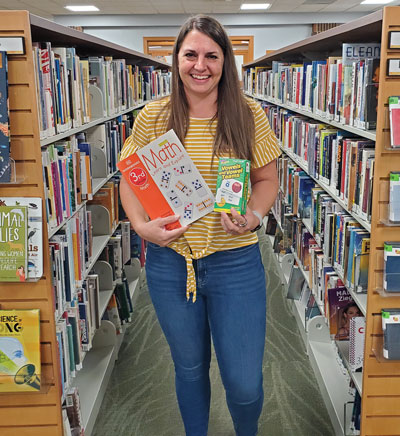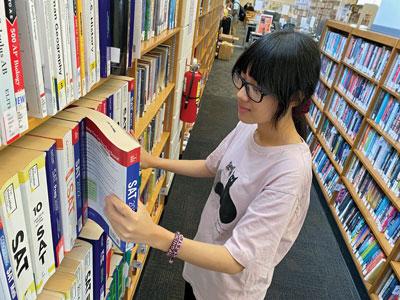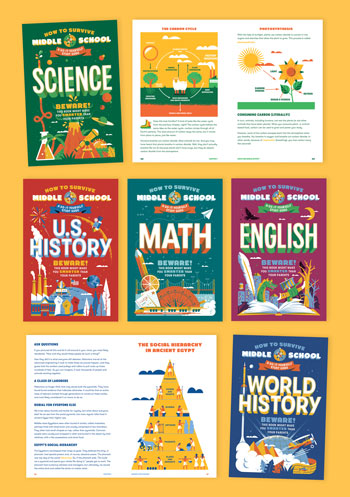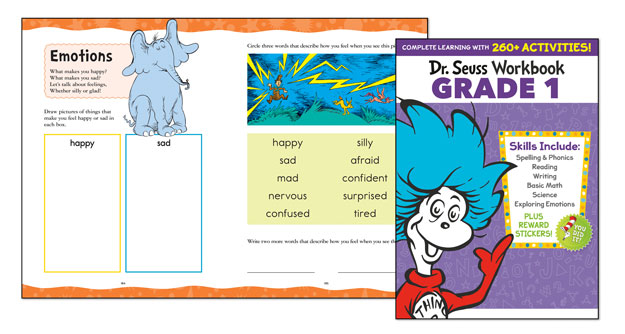Libraries Meeting Demand for Workbooks and One-Time-Use Resources
Writing in library books is typically against the rules, but many public libraries are stocking their collections with test prep workbooks and other materials designed to be written in.
 |
Delaware County District Library Youth Services Librarian Julie Kreakie in the Powell Branch Library. Kreakie was part of the DCDL team that developed the Student Learning Resource toolkit.Photo by Hillary Scholz |
It’s a golden rule of the library—please, don’t write in the books. Yet visit many children or teen collections, and you may find a variety of texts explicitly designed for just that.
The Queensboro Hill branch of Queens (NY) Public Library circulates an array of such materials. Some you might find in any library, like an SAT prep book. Then there are the hyperlocal items, like a workbook for New York’s Gifted and Talented program for children in preschool and kindergarten.
These types of materials are very popular, highly requested by parents, and rarely stay on the shelves for long—especially when big exams are right around the corner. But that demand comes with a price.
“It is a hard balance between offering something that by its nature requires interaction, and interaction therefore destroys its use for the next person,” says Queensboro Hill children’s librarian Ellen MacInnis.
Despite the paradox they present, workbooks remain an important part of any collection. Their value has only increased over the last few years during the COVID pandemic and remote learning.
Librarians and publishers are responding.
The role of “consumables”
Workbooks are exactly what they sound like: resources designed to support learning through practice problems and exercises to be answered directly on the page. These types of books are also referred to as “consumables” in the publishing industry and by librarians.
 |
A teen browses workbooks at the Queensboro Hill branch of Queens Public Library.Courtesy of Queens Public Library |
There’s a wide range of workbooks available, covering topics in PreK to grade 12. There are test prep workbooks for the SATs and the ACTs. There are workbooks that are subject-specific, from third-grade reading comprehension to middle school computer science, coding, and math skills. There are workbooks that deal with mental health, world geography, or just random trivia. Others are hybrids, like some entries in the “Diary of a Wimpy Kid” series, which contain only a few pages to be written in.
So, what is the role of the library in making available an item typically meant to be used once?
“It ties back into the library’s mission,” says Nicole Fowles, communications manager for Delaware County (OH) District Library. “We want to support children and caregivers, and we want to help them succeed and become lifelong learners. The library is not the place where you may go for your primary education, but where you can fill in some of the gaps you don’t get from school.” Workbooks play a big part in that.
A midsize library system in central Ohio, Delaware County Library has four branches that serve a diverse population of about 80,000 card holders, from a rural agricultural school district to another district with a school that has 68 languages spoken, including Mandarin, Spanish, and Hindi.
The Delaware County system has always offered workbooks, but in 2020, when it was clear that learning would take place at home, librarians realized parents would need access to resources to support and supplement their children’s classroom education. That meant adding even more workbooks to the collection. Today, in addition to 75 individual unique items, with multiple copies available among branches, the library has also added flashcards, which Fowles said began circulating prior to 2020, but in the last few years have begun to fly off the shelves.
The library also created a dedicated student learning resources page on its website, a “one-stop shop for everything” a parent or student might need to supplement their learning, Fowles says, with quick links to workbooks, flashcards, and online resources.
By circulating physical workbooks, Delaware County inevitably contends with patrons writing in the books. But Fowles says they have worked to encourage parents and children to find alternatives, like writing out questions on a dry-erase board or a piece of paper at home. Despite their best efforts, workbooks still tend to have a short life span.
“Most libraries have a shelf-life to each book they check out,” Fowles says. “Paperback books made for children we assume will circulate a certain number of times before they are destroyed. An SAT prep book is probably going to circulate six times before we aren’t going to feel proud about having it on the shelves.”
Fowles says the library evaluates and replaces worn-out workbooks twice a year thanks to a $192,000 juvenile book budget, of which about $8,400 goes to student learning materials.
But for libraries that can’t afford to replace workbooks as frequently, maintenance becomes extra important for keeping these types of books available.
“We do [our] best to make them last, fixing the bindings or erasing the pencil marks, to make sure people can get the most use out of them,” says Amber Loveless, community library manager at Queensboro Hill. Hers is just one of more than 60 branches in the Queens Public Library system, one of the largest and busiest public library systems in the United States, that serves a population of more than two million people. This year, her budget for the young adult and juvenile collections is a little over $2,000 for each.
 |
Recent Holiday House offerings include David A. Adler’s First Grade Math Workbook with illustrations by Edward Miller III andGail Gibbons’ Monarch Butterfly Workbook.Courtesy of Holiday House Publishing, Inc. Copyright © 2022 by Edward Miller III and Gail Gibbons, respectively. |
Copyright ins and outs
The children’s room at Queensboro Hill has about 20 different workbooks available. The teen section counts more titles, with workbooks covering national tests like the SATs, as well as local curriculum and tests, like New York City’s Specialized High School entrance exam. With a limited number of books to go around, it’s inevitable that some patrons will turn to copying sections of workbooks.
That gets into one of the stickiest issues of having workbooks in libraries. While the fair use doctrine allows the use of some copyrighted materials for educational and research purposes, that protection is murkier when it comes to reproducing consumables, like photocopying a practice test in an SAT workbook that’s meant for single use.
However, even if patrons decide to make copies of workbook pages, it wouldn’t necessarily be the library’s fault. According to Sara Benson, a lawyer and copyright librarian at the University of Illinois, as long as libraries have copyright law notices on their copy machines, and a librarian isn’t overseeing the use of the copier, it’s ultimately on the patrons to understand what they are doing.
“Say a student takes out the SAT prep book and copies the entire book, even at the library, it wouldn’t necessarily be the library’s liability because if they have the sign and the copier isn’t supervised, it’s on the patron,” Benson says. “Patrons are going to do all sorts of things, and if they choose not to listen, that’s beyond the scope of what the library can really do.”
 |
The “How to Survive Middle School”
|
A valuable pandemic resource
As in Delaware County, workbooks were an important support for students and parents during school closures in New York City.
Workbooks have been in heavy demand these last few years, Stephanie Anderson says. Anderson is the assistant director of selection at BookOps, a shared technical service between the New York Public Library and the Brooklyn Public Library responsible for meeting the collection management and distribution needs of both institutions.
In the past, the libraries avoided purchasing many consumables, with the exception of test prep books. But that has shifted during COVID. Now, in addition to offering test prep and other workbooks, BookOps also purchases workbooks on topics ranging from financial literacy to student mental health to give away to students through library programs.
“Hundreds of thousands of New York City students live below the poverty line, and schools can’t provide these resources, and parents rely on them,” Anderson says of the importance of making sure workbooks are available in the city’s libraries.
Before her current role in Queensboro Hill, children’s librarian MacInnis worked at the Bronx Library Center, the largest public library in the Bronx. The library closed in March 2020 and reopened in June, and almost immediately, there was a huge demand from parents for resources to help their children with missed school, MacInnis says. Workbooks were some of the best tools they had to offer.
Having access to the physical workbook was also critical for the community the Bronx library served. “Only about 20 percent of families had internet connections at home,” MacInnis says. “These books really were a lifeline for these families.”
Loveless and MacInnis add that while much of the demand for workbooks is driven by parents; it’s not just for the benefit of their kids. Math workbooks are particularly popular among parents themselves to learn the often-unfamiliar way math is taught in most curricula today, in order to better help their children. Queensboro Hill also serves a large community of first-generation parents who don’t speak English or are still learning.
“These test prep books are really helpful for parents wanting to make sure their children can succeed but who can’t oversee their child’s learning in English,” MacInnis says. “Workbooks bridge the gap, which is really important.”
 |
A Dr. Seuss workbook from Bright Matter Books, an imprint of Random House Children’s Books.From Dr. Seuss Workbook: Grade 1. Copyright © 2022 by Dr. Seuss. Published by Bright Matter Books, an imprint of Random House Children’s Books, a division of Penguin Random House, LLC. |
Publishers step up
During the first year of the pandemic, the sale of children’s workbooks exploded. And even as students have returned to in-person learning, the demand has remained strong.
“In that first year when kids were at home, parents were at a loss for how to support their children’s education,” says Mary Cash, vice president and editor in chief at Holiday House. Now, parents understand “how important parent or guardian support can be” and the benefit of having workbooks at home to help their children.
This year, Holiday House began publishing several math and STEAM-focused workbooks, including a pair adapted from the works of popular primary grade science writer Gail Gibbons.
While the education market has long been a cornerstone for Holiday House, the publisher expects to see its new workbooks flourish in a variety of educational settings, including libraries.
New Harbinger Publications produces a number of workbooks for kids and teens centered around mental health issues. Their “Instant Help” line of books, founded by child psychologist Lawrence Shapiro, provide evidence-based workbooks to help young people gain the skills to deal with mental health and life challenges. Titles include The Shyness and Social Anxiety Workbook for Teens and The ADHD Workbook for Kids . Pioneers in the self-help workbook, New Harbinger has made it easy for librarians and their patrons by granting permission to photocopy a percentage of their workbooks.
“We feel strongly that libraries help us with our mission to reduce human suffering by distributing our resources directly to the people who need them,” says Christopher Grady, New Harbinger senior sales representative.
Other publishers would prefer to see their workbooks purchased by individuals but also see the benefit of having workbooks in the library. Random House Children’s Books vice president and publisher Tom Russell oversees a number of popular workbooks, including Sylvan Learning and the Princeton Review test prep titles. He understands why they are popular in collections.
“I think there are reasons they can work in libraries, specifically in a time of need, if a kid is struggling or needs extra help,” Russell says. “During the pandemic, parents were looking for at-home resources and they turned to libraries in a heartbeat, and to have those resources available to look at and try out can be helpful.”
Random House Children’s expanded its portfolio during the pandemic, launching a brand-new imprint called Bright Matter Books with a number of new entries, including a series of workbooks based on Dr. Seuss characters for pre-K and elementary students and another series for older students called “How to Survive Middle School.”
With more workbooks becoming available, not to mention the annual updates of many test prep titles, MacInnis hopes that Queensboro Hill will continue to respond to the growing demand from patrons.
“I think these are really important books and would like to see more investment in them,” she says. “I’d say let’s try and get every branch some updated test books regularly. Because just as fast as education changes, sometimes two or three years out makes a big difference.”
Former classroom teacher Andrew Bauld is a freelance writer covering education.
RELATED
The job outlook in 2030: Librarians will be in demand
The job outlook in 2030: Librarians will be in demand
ALREADY A SUBSCRIBER? LOG IN
We are currently offering this content for free. Sign up now to activate your personal profile, where you can save articles for future viewing






Add Comment :-
Be the first reader to comment.
Comment Policy:
Comment should not be empty !!!